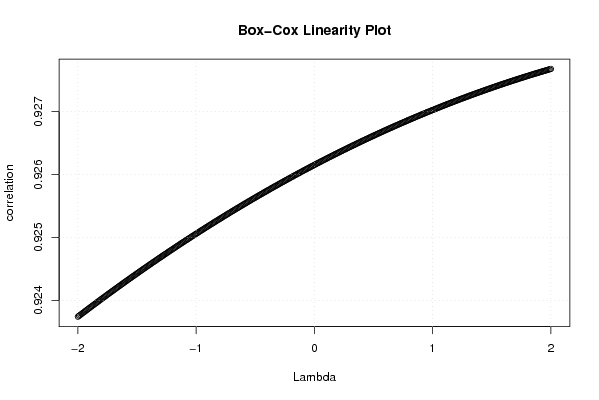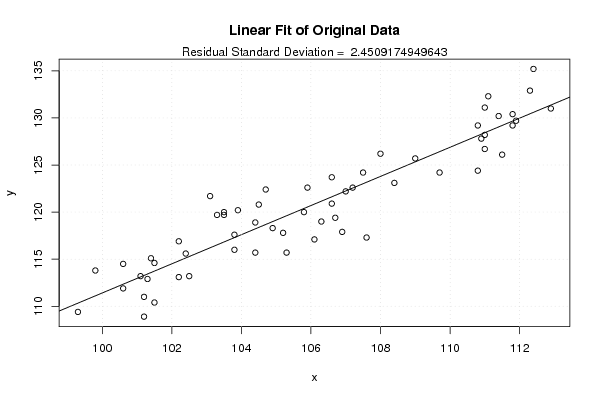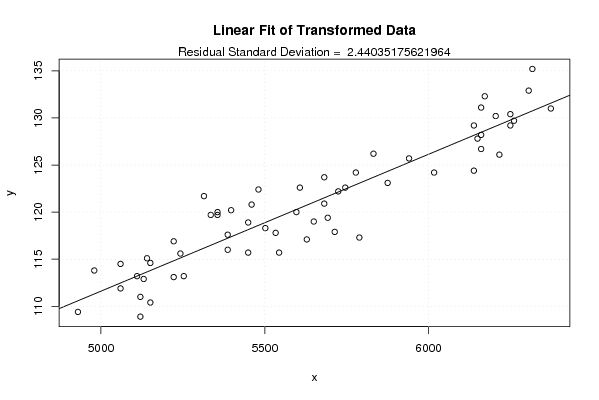Free Statistics
of Irreproducible Research!
Description of Statistical Computation | |||||||||||||||||||||||||||||||||||||||||||||
|---|---|---|---|---|---|---|---|---|---|---|---|---|---|---|---|---|---|---|---|---|---|---|---|---|---|---|---|---|---|---|---|---|---|---|---|---|---|---|---|---|---|---|---|---|---|
| Author's title | |||||||||||||||||||||||||||||||||||||||||||||
| Author | *The author of this computation has been verified* | ||||||||||||||||||||||||||||||||||||||||||||
| R Software Module | rwasp_boxcoxlin.wasp | ||||||||||||||||||||||||||||||||||||||||||||
| Title produced by software | Box-Cox Linearity Plot | ||||||||||||||||||||||||||||||||||||||||||||
| Date of computation | Tue, 11 Nov 2008 12:41:32 -0700 | ||||||||||||||||||||||||||||||||||||||||||||
| Cite this page as follows | Statistical Computations at FreeStatistics.org, Office for Research Development and Education, URL https://freestatistics.org/blog/index.php?v=date/2008/Nov/11/t1226432574ampv0c25rmf36t0.htm/, Retrieved Sun, 19 May 2024 09:40:12 +0000 | ||||||||||||||||||||||||||||||||||||||||||||
| Statistical Computations at FreeStatistics.org, Office for Research Development and Education, URL https://freestatistics.org/blog/index.php?pk=23891, Retrieved Sun, 19 May 2024 09:40:12 +0000 | |||||||||||||||||||||||||||||||||||||||||||||
| QR Codes: | |||||||||||||||||||||||||||||||||||||||||||||
|
| |||||||||||||||||||||||||||||||||||||||||||||
| Original text written by user: | |||||||||||||||||||||||||||||||||||||||||||||
| IsPrivate? | No (this computation is public) | ||||||||||||||||||||||||||||||||||||||||||||
| User-defined keywords | |||||||||||||||||||||||||||||||||||||||||||||
| Estimated Impact | 105 | ||||||||||||||||||||||||||||||||||||||||||||
Tree of Dependent Computations | |||||||||||||||||||||||||||||||||||||||||||||
| Family? (F = Feedback message, R = changed R code, M = changed R Module, P = changed Parameters, D = changed Data) | |||||||||||||||||||||||||||||||||||||||||||||
| F [Trivariate Scatterplots] [Various EDA topic...] [2008-11-11 17:33:56] [cf9c64468d04c2c4dd548cc66b4e3677] F RMPD [Box-Cox Linearity Plot] [Various EDA topic...] [2008-11-11 19:41:32] [e4cb5a8878d0401c2e8d19a1768b515b] [Current] | |||||||||||||||||||||||||||||||||||||||||||||
| Feedback Forum | |||||||||||||||||||||||||||||||||||||||||||||
Post a new message | |||||||||||||||||||||||||||||||||||||||||||||
Dataset | |||||||||||||||||||||||||||||||||||||||||||||
| Dataseries X: | |||||||||||||||||||||||||||||||||||||||||||||
101,5 101,3 99,3 100,6 101,2 99,8 100,6 101,1 101,2 101,5 102,2 102,5 101,4 103,8 105,2 105,3 104,4 104,9 106,9 107,6 106,7 106,1 106,3 105,8 104,4 103,8 102,4 103,3 103,5 104,5 103,5 103,9 103,1 102,2 104,7 105,9 106,6 106,6 107,5 107,2 109 108,4 107 108 110,8 110,9 109,7 111 111,5 111 111,8 111,4 110,8 111,9 112,9 111,8 111 112,3 112,4 111,1 | |||||||||||||||||||||||||||||||||||||||||||||
| Dataseries Y: | |||||||||||||||||||||||||||||||||||||||||||||
110,4 112,9 109,4 111,9 108,9 113,8 114,5 113,2 111 114,6 113,1 113,2 115,1 117,6 117,8 115,7 115,7 118,3 117,9 117,3 119,4 117,1 119 120 118,9 116 115,6 119,7 119,7 120,8 120 120,2 121,7 116,9 122,4 122,6 123,7 120,9 124,2 122,6 125,7 123,1 122,2 126,2 124,4 127,8 124,2 126,7 126,1 128,2 130,4 130,2 129,2 129,7 131 129,2 131,1 132,9 135,2 132,3 | |||||||||||||||||||||||||||||||||||||||||||||
Tables (Output of Computation) | |||||||||||||||||||||||||||||||||||||||||||||
| |||||||||||||||||||||||||||||||||||||||||||||
Figures (Output of Computation) | |||||||||||||||||||||||||||||||||||||||||||||
Input Parameters & R Code | |||||||||||||||||||||||||||||||||||||||||||||
| Parameters (Session): | |||||||||||||||||||||||||||||||||||||||||||||
| Parameters (R input): | |||||||||||||||||||||||||||||||||||||||||||||
| R code (references can be found in the software module): | |||||||||||||||||||||||||||||||||||||||||||||
n <- length(x) | |||||||||||||||||||||||||||||||||||||||||||||

















